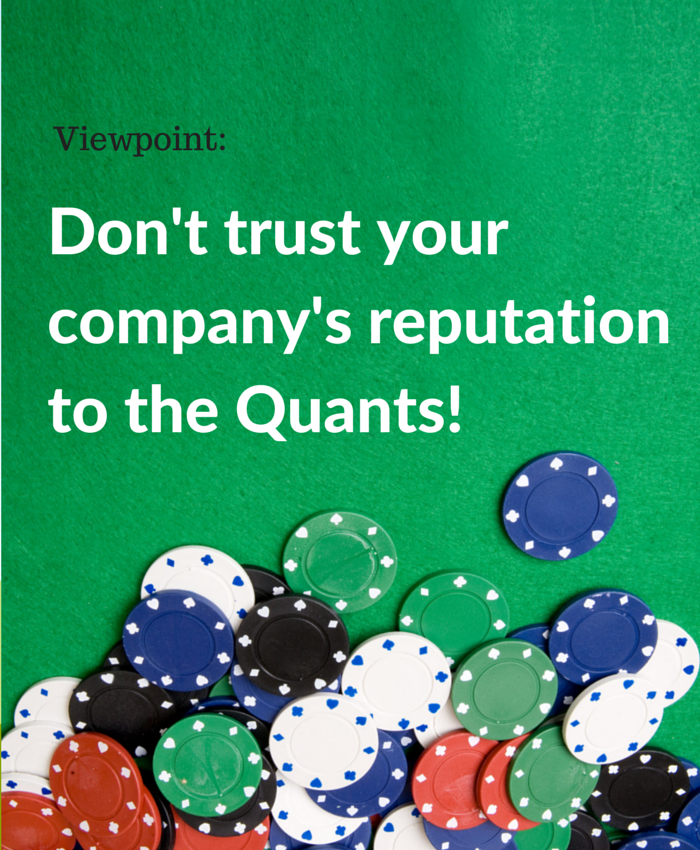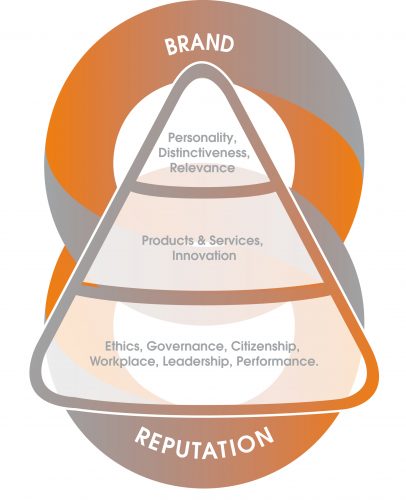
Don’t trust your company’s reputation to the quants!
Below we share an article first published in Harvard Business Review back in 2014. The writers argue the need for both qual and quant research in order to fully understand reputation. It’s an argument that resonates with Tovera. We advocate the use of both research methods in order to get the most rounded, informed view of the state of a company’s reputation and what’s driving it.
Don’t Trust Your Company’s Reputation to the Quants
First published AUGUST 4, 2014
Inversion is all the rage – and it’s sparking rage, too. Companies are employing or considering the complex and controversial tax maneuver to relocate their headquarters to countries more tax-friendly than the U.S. and save bundles. Pfizer is perhaps the largest corporation to attempt inversion. (The deal fell through.) Walgreen’s and as many as 30 other deals reportedly are in the pipeline.
From a cost-reduction standpoint, inversion is perfectly logical: Change your address and your tax bill goes down. And isn’t lowering costs exactly what managers focused on shareholder value are supposed to be doing? But railing against the practice are critics of all kinds, from President Obama on down. They say that anyone opting for inversion lacks patriotism – and is ripping off taxpayers.
We find the debate interesting because it offers a great example of reputation risk – and more specifically, of why such risk has to be assessed both quantitatively and qualitatively. Over the decades, risk management has become a deeply quantitative endeavor. But as damage to institutional reputations becomes a more potent threat, that overwhelmingly quantitative bias won’t serve organizations well.
Certainly, business leaders worry about reputation risk. In a recent series of studies by accounting firm EisnerAmper, it emerged as a top concern of board members. They know it is linked to risks of other kinds. Consider the reputation damage caused by product failure at GM, or unpopular workplace practices at Walmart, or the multibillion dollar fines for fraud levied against Bank of America – which, not incidentally, came in dead last in a recent Harris Interactive reputation ranking. But they also know that reputations can damaged by more than the operational risks that can be managed with functional redundancies, or the financial risks that can be countered by hedging, investing in futures markets, and global currency diversification.
Understanding how to manage reputation risk starts with understanding the elements of reputation. So let’s look at that research by the Harris Interactive team. For each of the past 15 years, they have calculated the RQ (reputation quotient) of 60 highly visible companies in the eyes of the American public by measuring perceptions of those companies in six major areas:
Social responsibility
Emotional appeal
Products and services
Vision and leadership
Financial performance
Workplace environment
The top 10 in the most recent Harris ranking are for the most part brands that consumers do business with directly, such as Amazon, Coca-Cola, and Whole Foods. (This finding mirrors the results of Edelman’s annual Global Trust Barometer.) By contrast, the bottom 10 includes several companies – Goldman Sachs, AIG, Halliburton, Monsanto, and BP — which most consumers know only by reputation. When everything in the news about a firm is bad, and the average person has no personal experience running counter to what they hear, reputation scores plunge.
Looking at the Harris study at a more granular level, it’s possible to see which of the particular elements it measures are the strongest drivers of RQ. Companies with strong reputation scores tend to post high marks for vision and leadership, employee satisfaction, social responsibility, and customer service; the bottom feeders score low on these. Similarly, the Edelman Trust Barometer is able to determine which components of its index carry most weight in people’s overall impressions of companies’ trustworthiness. Over the years, those trust drivers have shifted:
From “micro” impressions of firms in isolation to more “macro” impressions of firms and their networks of suppliers and contractors
From satisfaction with positive transactions to perceptions of shared values with the firm
From respect for firms that play by the rules (strictly comply with legal and regulatory requirements) to respect for firms with principles (who show leadership in responding to heightened societal expectations).
Think about these key drivers of reputation and trust and it starts to become clear why the quantitative methods that you probably rely on to address risk in other areas will never be sufficient. Reputation will always be too impressionistic, and too long-term in its impact, to be left to your Quants. Indeed, if you do leave it to the Quants, it will most likely be neglected, along with other risks that involve intangibles. In a recent survey of risk executives by the American Institute of CPAs, more than a third of respondents admitted they conduct no formal assessment of strategic, market, and industry risks.
We’d like to propose a solution. In your boardroom and senior management strategy sessions, make an explicit effort to listen to your “Qualts.”
What – or who – is a Qualt? He or she does not lack for rigor, but insists that managing reputational risk requires qualitative as well as quantitative experience and instincts. Your Qualts have internalized the values and larger purpose of the organization, and grasp how powerful these are in maintaining healthy connections between the company, its customers, employees, and other stakeholders. In a world with expanding transparency, heightened customer expectations, fragmented authority structures, social media that “negotiate” truth, and potent NGOs, they are the leaders who appreciate the interdependencies of these elements and the potential consequences of running afoul of society’s expectations.
Qualts tend to come to the fore in moments of crisis because, if the rankings of BP, AIG, and Goldman are any indicator, failing to lead well through a crisis carries a price that endures. At such moments, risk, and particularly reputational risk, gets elevated to a senior-leadership concern – and those executives ensure that its importance percolates throughout the organization. It should be no surprise that most “best practice” crisis-recovery examples (e.g., P&G, Exxon, J&J) show organizations shifting to fully integrated risk-management platforms, which build reputational considerations into the full “supply chain” of risk-based decision making.
But a crisis is a tough time to start managing in an unaccustomed way. Qualts understand that reputations and long-term value accrue through consistent commitments over time. They see rigorous quantitative approaches to risk as necessary but not sufficient, since any purely numbers-driven risk analysis of deeply subjective components such as “emotional appeal” or ”vision and leadership” is only suggestive of the truth, at best. In fact, the equations can overlook or mask fragility.
Of course, risk-taking is central to business success. But Qualts appreciate more than anyone else how succumbing to immediate financial temptations can mortgage a reputation, creating reputational debt. They maintain and evolve decision-making models that guide those decisions with clear reputational standards that remain inviolate up, down, and across the extended enterprise.
Our intention here is not to denigrate the Quants who are doing so much to illuminate risks across the enterprise, and finding ever more sophisticated ways to track reputational changes over time. Our warning is that reputation risk management is a special case. Its foundational elements – values and emotions – are frankly qualitative and managing wisely will always require a Qualt.

